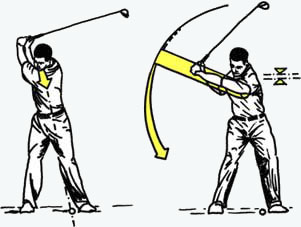
In the past beginners
have been preached the theory of the physical pendulum motion and golf
instructors have demonstrated what they have thought to be the relationship
between the pendulum motion and the golf swing, but today there are schools
which use the pendulum motion as the fundamental element for the teaching
of the golf swing. Professor Manfred Grosser, for example, uses the pendulum
motion as basis for his Universal Golf Learning System (U.G.L.S.).
Also
Carving Golf has developed its teaching theory and spezialized equipment
(clubs) based on the physical pendulum motion and its relationship to
the golf swing. However there still exists uncertainty as to the general
acceptance of the pendulum motion as the basis for the golf swing.
First we must study the swinging motion of the pendulum. Here it is understood that an object attached to a fixed central point (moment of inertia) is set in motion downwards. The object’s speed is affected by gravitational force, but can also be accelerated by external forces. To optimize the pendulum effect, the external force must be indirect relation to the direction of the pendulum movement (downwards) and in the same frequenz as the pendulum. If we continue to explore further the technical mechanics and the direction of the external force on the pendulum, we know that the motion of a clock’s pendulum is vertical and works together with other components of the clock in this vertical level. However with the angeled plane of the golf swing, it is also necessary that the forces necessary to accelerate the pendulum of the golf swing must also be precisely at the same angle.
Back to the golf swing
After we have understood the influence of the external forces on the pendulum motion and its relation to the swing plane of the golf swing, we can now explore in further detail the specifics of
1) the Arm-Golfclub pendulum motion at the start of the downswing. The shoulder acts as the fixed central point (moment of inertia) around which the physical pendulum motion is based.
2) how the frequency relates to the center of the Arm-Golfclub pendulum motion and is responsible for accelerating the pendulum motion. The angular acceleration is determined by the position of the golf ball and the swing plane.
The Swing System first recognizes the pendulum motion with short accelerated swinging motion as a pendulum, but as force or power are increased, the direction and the dynamic of the pendulum swing are developed.
Playing professionals
have recognized the pendulum as the basis of their powerful golf swings. Tiger Woods describes the feeling of accelerating his arms during the start of the downswing: “My arms feel like they are falling.” (Golf Digest, January 1998). Ernie Els explains how to increases power in the golfwing using the pendulum motion as a basis:
“Pull your left shoulder away from your chin.”
(Golf Digest, September 1997).

Increase of
energy from the power impulse at the moment of inertia.
Dropping the shoulder “away from
the chin” in the direction of the ball against the center of gravity
of the arm-golf club pendulum system.
nical energy of the pendulum phenomenon.
Dropping of the shoulder “away from the chin” in the direction of the ball and activation of the pendulum motion through the swing tempo and the power impulse.
The dropping of the shoulder activates the power impulse from the moment of inertia and the dynamics of the pendulum motion.
Anatomy Makes it Possible
The phenomenon of the „shrug of the shoulders“ is well known. The shoulder rise vertically toward the ears and fall back down again. However it is possible that during the backswing the shoulder do not rise vertically towards the ears, rather at an angle more to the chin. When the shoulder then drop vertically, the stance position remains consistent, but the swing plane changes. It is amazing what this small change in the movement of the shoulder causes, especially when the pendulum dynamics are considered. Try it for yourself and you will see the results.
Should you require more information, please contact the Carving Golf School. Educated Sports Teachers are specialized in this area.